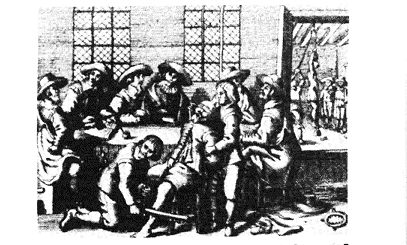

Inquisitions of Ireland
| Witch Trials of Ireland Witchcraft almost, but not entirely bypassed Ireland. The relative isolation of the country, the separation between the ruling Protestant minority and the indigenous Roman Catholic majority, and the total absence of writings or controversy about witchcraft are some circustances that might account for Ireland's immunity. Between the first and last trials in 1324 and 1711, not more than half a dozen others are recorded. Curiously, with the exception of the first, they were all of Protestants by Protestants. ** Bibliographies will now be added, as I have been told to get my facts straight, that
Ireland never had any Witch Trials. 1317 Dame Alice Kyteler was charged with Heretical sorcery. She had been married
four times 1327 Adam Dubh, of the Leinster tribe of O'Toole, was burnt alive on College
Green for denying 1353 Two men were tried at Bunratty in County Clare for holding heretical
opinions, and were 1578 36 People are Jailed, Two Women and One Black Man were executed. The man on charges of Nigromancy, necromancy believed to be held predominately by this race. The Women charged by natural law. 1586 James I - The Irish Parliment passed Queen Elizabeth's bill of 1563, not repealed until 1821. Death penalty for murder by sorcery, a year's imprisonment and the pillory for witchcraft not deadly. Property was forfeit only on conviction for a second offense, and only in crimes of divination, attempted murder, and unlawful love. 1606 A Minister was tried for invoked "wicked and lying spirits". He was sent to England for the trials, and his ultimate fate is unknown. 1609 A possessed girl was cured by a holy girdle from Holy Cross Abbey, near Thurles. Recorded in the County of Tipperary, accounts of magickal spells being counteracted by the application of a holy relic. 1613 John Stewart was apprehended as the accomplice of a Scottish Witch name Margaret Barclay. 1634, November A Rev. Robert Blair, M.A., was excommunicated because of his "impression of spirits". 1640 August 13, The Lord of Castleconnell's Castle four miles from Limerick was reported as being a sorcerer. 1644 A poltergeist near Limerick anticipated the Drummer of Tedworth by 18 years; another followed in Dublin 16 years later. 1661 Florence Newton at Youghal was committed to Youghal prison by the Mayor of
the town March 24th. Two other women were suspected in this trial, Goody Halfpenny and
Goody Dod, but neither of them were punished. Florence is charges with hexing a young
servant girl, she was tortured in several ways, of which the accuser's urine is boiled and
then "dropped on the witch", awls were put into both of her hands to see if she
would bleed, and there is mention of her having the "test of the tile" but there
is no description of this method. There is no record of what became of Florence Newton,
but most likely she had been sentenced to death. 1685 Margaret Matthews was the wife of an accused man, He was sent to prison for being a sorcerer. Margaret was taken into custody and refused to claim guilt, She died a month later November 1, 1685 of the injuries she had received in torture. 1699 A pamphlet is produced of a 9 year old girl bewitched by a beggar woman.
The Girl went into violent fits of vomiting all sorts of odds and ends. The Beggar woman
had been sentenced, strangled and then burned. 1710-11 The Trials predominately for Ireland are over with the exception of
Island Magee, near Carrigfergus, in the County of Antrim, and Province of Ulster. A girl
of 18 Years old had named 7 or 8 women who sopposedly haunted her. March 3 & 24,
depositions were sworn and the seven women were arrested, brought to trial, all found
guilty, and all sentenced to a year in prison. 1911 Last record of Witchcraft being a crime or in court in Ireland, an unhappy poor woman was tried for killing another, an old-age pensioner, in a fit of insanity. Other Sources: |
MuTiLaTeD by a BugBear